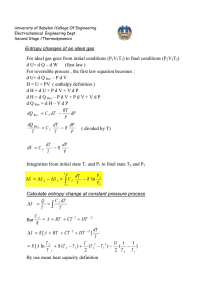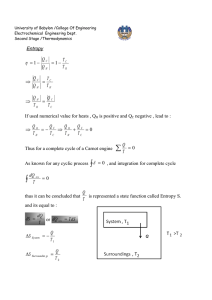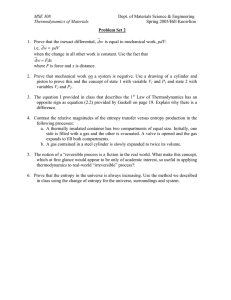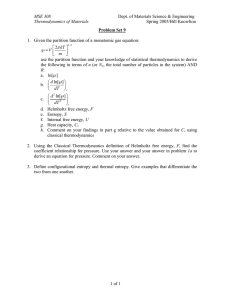University of Babylon /College Of Engineering Electrochemical Engineering Dept. Second Stage /Thermodynamics
advertisement
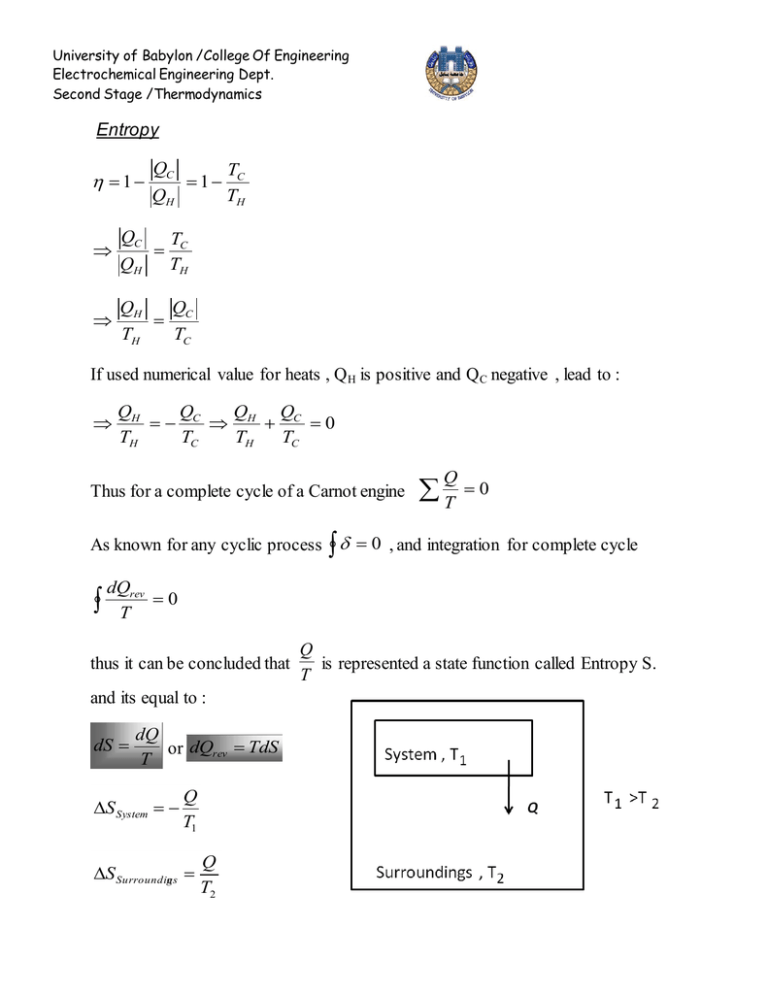
University of Babylon /College Of Engineering Electrochemical Engineering Dept. Second Stage /Thermodynamics Entropy 1 QC QH QH TH QC QH 1 TC TH QC TC TH TC If used numerical value for heats , Q H is positive and Q C negative , lead to : Q Q QH Q C H C 0 TH TC TH TC Thus for a complete cycle of a Carnot engine Q T 0 As known for any cyclic process 0 , and integration for complete cycle dQrev 0 T thus it can be concluded that and its equal to : dS dQ or dQrev TdS T S System Q T1 S Surroundings Q T2 Q is represented a state function called Entropy S. T University of Babylon /College Of Engineering Electrochemical Engineering Dept. Second Stage /Thermodynamics STotal Q Q is a positive value , and for irreversible process the entropy T1 T2 change is a positive , all spontaneous process [∆S ≥ 0 ] STotal Q Q Q(T1 T2) T1 T2 T1T2 Since T1 > T2 , the total entropy changes result from this irreversible process is positive , ∆S Total becomes smaller as the difference between T 1 and T2 get smaller. Since entropy is a state function , the entropy change of any system and its surroundings considered together is positive and approach zero. Where ∆S Total = ∆S System + ∆S Surroundings ≥ 0 When a process is reversible and adiabatic dQ is constant . Rev. = 0 , thus the entropy of system During irreversible adiabatic process and the process is said to be isotropic dQrev TdS dQ rev S2 T dS S1 S2 QRe v TdS S1 The integration represent an area under curve , in this case entropy is the lost work. University of Babylon /College Of Engineering Electrochemical Engineering Dept. Second Stage /Thermodynamics Heat Engine Heat engine involve a working fluid to and from which heat is transferred Receive heat Q from high temperature source. Concert part of this heat to work. Reject the remain with heat Q to low temperature sink. For Carnot engine and by equating the two below equations T1 T2 W and T1 Q T Q(T1 T2 ) W T1 T2 W Q1 2 Q T1 T1 T1 This is the maximum work can be got , During the first case , the work lost is W (STotal )(T2 ) Generally T2 is represented surroundings temperature . Entropy changes of an ideal gas For ideal gas goes from initial conditions (P 1V1T1) to final conditions (P 2V2T2) d U= d Q – d W (first law ) For reversible process , the first law equation becomes : d U= d Q Rev – P d V H = U + PV ( enthalpy definition ) dH=dU+PdV+VdP d H = d Q Rev – P d V + P d V + V d P d Q Rev = d H – V d P RT dQRe v C P dT dP P dQRe v dT dP CP R ( divided by T) T T P University of Babylon /College Of Engineering Electrochemical Engineering Dept. Second Stage /Thermodynamics dT dP R T P dS C P Integration from initial state T 1 and P1 to final state T 2 and P2 T2 CP S S 2 S1 T1 P dT R ln 2 T P1 Calculate entropy change at constant pressure process Q C dT S P T T But CP A BT CT 2 DT 2 R S R[ A BT CT 2 DT 2 ] R[ A ln dT T T2 C D 1 1 B(T2 T1 ) (T22 T12 ) ( ) T1 2 2 T2 T1 By use mean heat capacity definition T2 C Pms C P dT / T T1 ln(T2 / T1 ) The subscript ms denote a mean value specific to entropy calculation CPms D A BTlm TamTlm C R (T1T2 ) 2 Where Tam is arithmetic mean temperature , and T lm is the logarithmic mean temperature Tlm T2 T1 ln(T2 / T1 )
